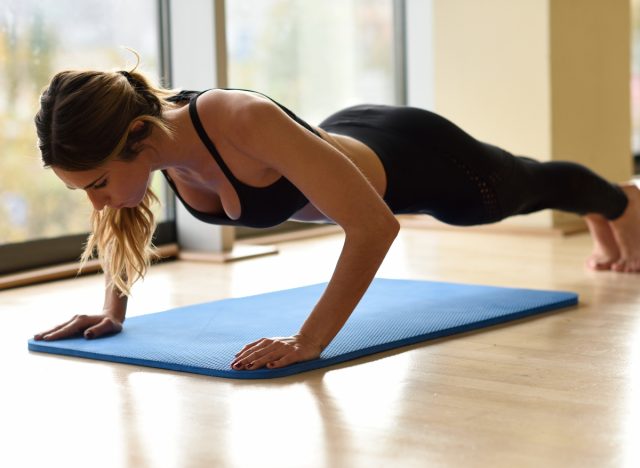If You Can Do This Many Pushups, You're in Good Shape

Pushups are one of the simplest yet most effective ways to gauge your fitness level. They require only your body weight and a flat surface, making them the ultimate test of relative strength—how well your muscles can move your body. While many exercises focus on lifting external weights, pushups target your ability to press your body off the ground, challenging the chest, shoulders, triceps, and core. Performing a solid number of pushups suggests that you have the muscle strength and endurance to maintain a steady rhythm without compromising form.
Regarding functional fitness, relative strength exercises like pushups and pull-ups clearly show how your body performs in real-world situations. These movements translate directly into daily activities, from pushing a door open to picking yourself up off the ground. Your ability to move your body through space becomes even more critical as you age, helping with balance, coordination, and injury prevention. Pushups, in particular, are a great measure of this strength as they engage multiple muscle groups simultaneously, making them an efficient full-body exercise.
In this article, I'll explore how many pushups are considered a good indicator of being in shape, break down the art of a perfect pushup, and explore strategies to improve your pushup strength. Whether you're aiming to crush a fitness challenge or just want to build overall strength, this guide will help you progress to the next level of your fitness journey.
If You Can Do This Many Pushups, You're in Good Shape

When it comes to pushups, there's no one-size-fits-all number, but there are general benchmarks that give you a solid sense of where you stand.
You're ahead of the curve if you can knock out 20 consecutive pushups with proper form. That said, the magic number varies depending on your age, gender, and fitness level. For example, men in their 20s should aim for 30-40 pushups, while women in the same age range should shoot for 15-20. Hitting these numbers means you've got strong upper-body muscles, solid core control, and muscular endurance.
For those in their 30s and 40s, it's natural to see a slight decline, but don't let that be an excuse to slack off! Men who can crank out 20-30 pushups and women who can do 12-15 are still well within the "fit" zone.
By the time you hit your 50s and 60s, maintaining the ability to perform 10-20 pushups for men and 5-10 for women is a solid goal. And don't worry if these numbers seem high right now—building up to these benchmarks is doable with the right plan.
Remember, the point isn't just about chasing numbers. Pushups are a functional movement that translates to real-life tasks like lifting, pushing, and stabilizing your body in daily activities. If you can consistently hit these numbers, you're not just "in shape"—you're ready for whatever life throws your way, from tackling a challenging workout to hauling heavy groceries.
The Art of a Correct Pushup

A pushup only counts if you do it right. No cheating with half-reps or sagging hips!
- To perfect your form, start in a high plank position with your hands placed shoulder-width apart and your body in a straight line from head to heels. Think of your body as a board—no bending, no arching.
- Engage your core and glutes to keep your hips in line, and make sure your neck stays neutral by looking slightly ahead of you.
- Lower your body by bending your elbows at a 45-degree angle, bringing your chest just an inch or two above the floor.
- Keep your elbows tucked toward your torso (not flaring out to the sides), and press evenly through both hands as you push back up.
The key is control—don't rush through the movement. It's about quality over quantity here, and a slow, controlled pushup engages more muscle fibers and prevents injury.
In addition, don't forget to breathe! Inhale as you lower yourself and exhale as you press up. A controlled breathing pattern helps you stay steady and fuels your muscles with the oxygen they need to keep going.
Perfecting this form will unlock the full benefits of the pushup and ensure that every rep counts.
How to Increase Your Pushup Strength

Ready to crank out more reps? The key to pushup progress is a mix of volume and variety.
First, increase the number of pushups you do in a single set. If you're currently at 10, aim for 12-15 over the next few workouts. Push your limits, but never at the expense of form. Once you've mastered higher rep counts, add variations to keep your muscles guessing.
Start with incline pushups (placing your hands on a bench or surface higher than your feet) to build endurance. As you get stronger, work your way down to regular pushups. Feeling confident? Move on to decline pushups (with your feet elevated) to crank up the intensity. For an even more significant challenge, mix in plyometric pushups—where you push off the ground explosively so your hands leave the floor.
Strength training outside of pushups is just as important. To strengthen the muscles you rely on during pushups, incorporate exercises like bench presses, tricep dips, planks, and even pull-ups.
Lastly, don't forget rest and recovery. Your muscles need time to rebuild after working hard, so take at least 48 hours between intense pushup workouts.
Follow this plan, and soon you'll be smashing those pushup goals!









